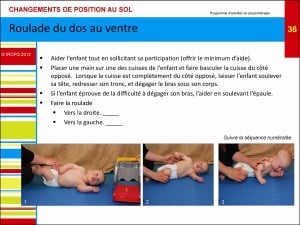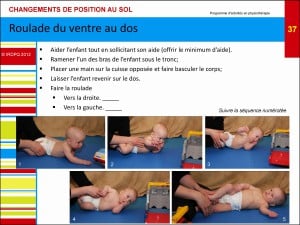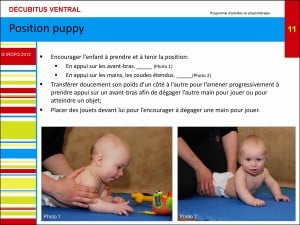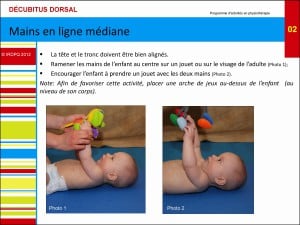To read the previous section, see The development of babies from 0 to 3 months.
Your child is growing fast, and they will become more active and awake during their daily lives.

Your baby is more toned, meaning that they can hold themselves up more. Around four months, they can support themselves on their two elbows while on their stomach and transfer their weight to free an arm to grab an object placed in front of them. This stage reinforces the muscle chain allowing them to roll, balance themselves, bring their feet to their mouth. They’re so flexible it’s crazy! It’s disappointing this flexibility diminishes with time, right? 😊
The ability to roll during this period is important for a child for their autonomy, moving around and the variations in their sleep positions.

Something you should note here — “It’s very important to learn how to sit before you can stand, it’s an essential first stage.”
At the affective level, around six months the baby has consciousness of others, they’re a separate person from their mother, they see and are in contact with their environment in a more voluntary way.
 Suggested activities for babies from 4 to 6 months
Suggested activities for babies from 4 to 6 months
- Stimulate rolling:
Rolling on both sides is a fun activity at this age. We can lightly bring their bent hip to one side and at the same time encourage the child to look to the opposite side to stimulate the desire to roll by transferring their weight.


Sometimes babies are scared, as they have the impression of falling by doing this on their own, and they can even cry. By playing with them, we get them to do it and when they succeed we applaud them. The baby will find that fun to see our reaction and their fear will dissipate.
- The stomach position with well-positioned elbows and hands:
This position will get the child to try to grab an object that you will have placed in front of them according to their age. During this learning stage, the activity mat as it includes fun and exciting items that attract the baby. You will start this position at a younger age, but here we practice it by progressively increasing time. The baby will have spent 60-90 minutes per day on their stomach.

- Promote opening the arms and hands:
Baby is lying on their back with objects placed above them to get them to grab the toy. If your baby is sitting, put toys around them.

- A mirror:
Placed on the wall beside their changing table, a mirror allows the baby to see themselves, as they’re now conscious of others being present.

- The rattle:
It’s a toy that babies from 4 to 6-month-old babies love, due to the sound, but remember, they will always want to play with it. This toy can get them to roll while playing games with you. x x
- Floating toys in the bath:
These also draw the attention of the baby who is sitting in the tub. They unsuccessfully try to grab them (arms out in front or to the sides, which is very good).
- Talk, sing:
Your baby needs to hear you, for you to name things, name emotions (happy, angry, sad). They will learn imitating you.
If you’re looking for a reference for game ideas or toys based on your child’s age, I suggest Et si on jouait? by Francine Ferland published by éditions Sainte-Justine.
You want to read about the motor development of babies from 7 to 9 months and 10-12 months? I’m so happy! Read my articles on Baby motor development from 7 to 9 months and 10-12 months.
You can also watch my Facebook live video on motor development from 0 to 12 months (in french) that I filmed with the physiotherapist Cynthia Fontaine.
Talk soon,
Marie
The Baby Expert


